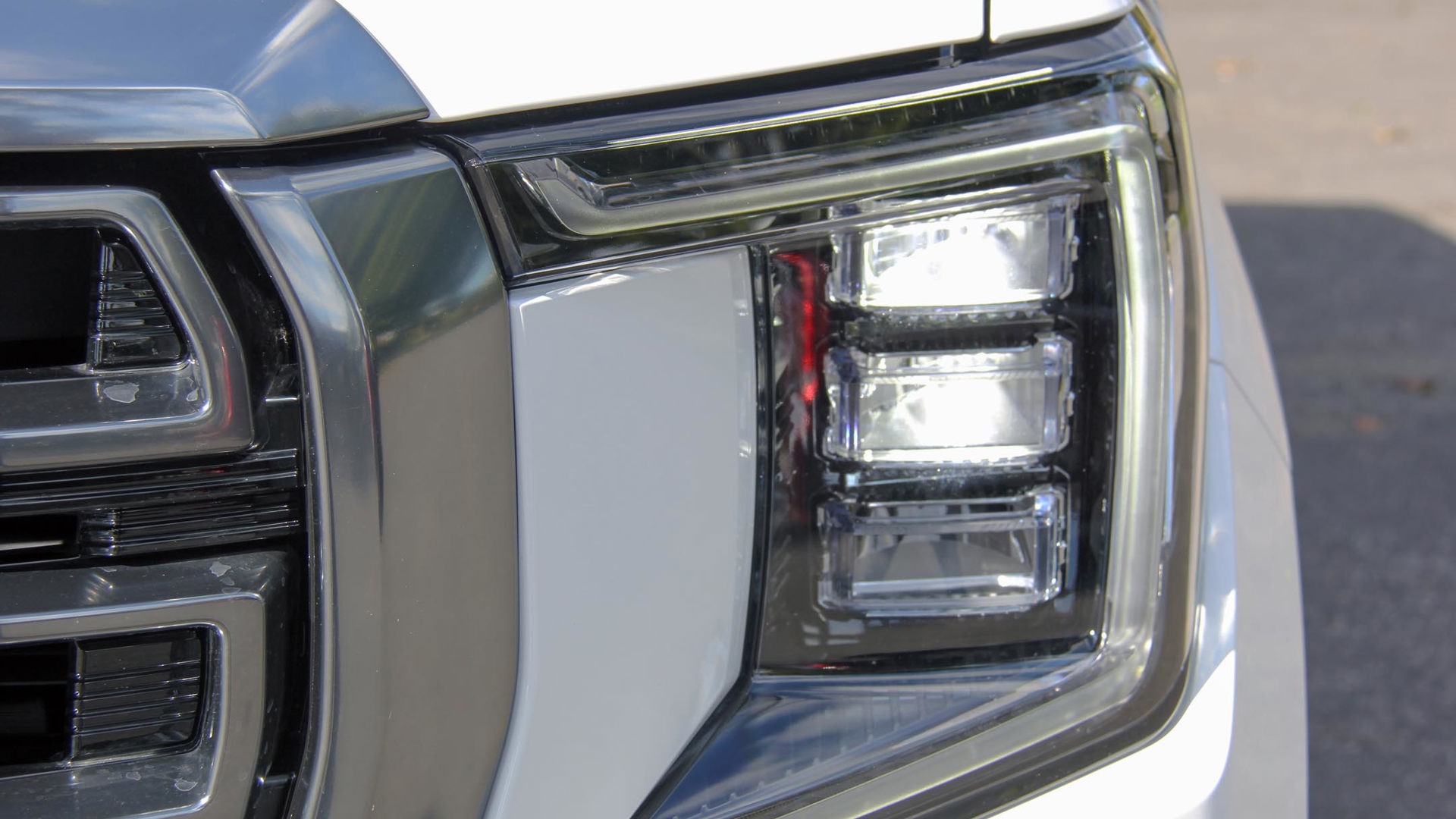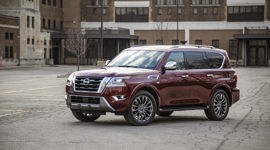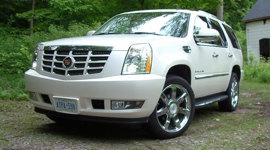Apart from the badging, the differences between the Chevrolet Tahoe and GMC Yukon have not always been easy to identify.
Offered at different retailers, they essentially looked and drove the same. The 2021 model year sees the two brands diverge in order to appeal to different customers through unique parts, packaging, and trim options. For GMC, the Yukon receives the rugged AT4 treatment from its Sierra sibling and sees the Denali go decidedly upmarket without stepping on the toes of the sacred Cadillac Escalade.
As was the case with the previous four generations, the 2021 GMC Yukon is also available as an extended-wheelbase Yukon XL (known as the Suburban at Chevrolet). If for some outlandish reason you didn’t think that the previous Yukon and Yukon XL had enough space to transport people and things, they now offer larger proportions and more room. Passenger and cargo room have both increased thanks to a 25 mm increase in overall length, a 102 mm increase in track (the distance between the wheels left and right), and independent suspension at all four corners. Despite their larger dimensions, both feel sprightlier from behind the wheel since steering, ride quality, and handling are much improved.
Three suspension offerings are now available: coil springs and conventional shocks and struts are standard on SLE and SLT; magnetorheological dampers come equipped on the AT4 and Denali models; while adaptive air suspension is available on those two variants.
The latter smoothly and rapidly adapts to road conditions and allows the large SUV to feel planted and stable on rough or uneven surfaces. New for 2021, the air suspension noticeably improves ride quality and handling, but it also provides 100 mm (4 in) of ride height adjustability, with maximum height available with four-low engaged, or the lowest setting for easier access when parked. Manually adjustable based on preference, the system will automatically default to the lower setting at highway speeds for improved aerodynamics.
New Features
Wireless Apple CarPlay and Android Auto are now offered as standard equipment across the board. The wireless charging pad has also been moved from the centre console armrest to a more convenient location beneath the HVAC controls. The available powered centre console is capable of moving 254 mm (10 in) rearward at the push of a button. This allows rear passengers access to HVAC and heated seat functions, as well as USB and HDMI ports, while providing front occupants a cavernous covered storage area.
The 10.2-inch infotainment system offered on SLT, AT4, and Denali trim levels is intuitive and easy to navigate. Eight camera views are offered through the system, with an additional one accessible within the rearview mirror. It takes some getting used to but comes in handy when the back half of the vehicle is filled with passengers or cargo. Meanwhile, 360-degree vision helps with parking such a large vehicle, while a specific hitch view makes hooking up to a trailer simple and easy.
Second-row seating features a pair of available 12.6-inch tilting touchscreen that are capable of screen-sharing. No DVD player is included, so external systems can be plugged in through USB or HDMI. Navigation is also integrated, so rear passengers can punch in a destination to share with the driver.
The optional head-up display (HUD) has been enlarged and improved for 2021. Now measuring 15 inches, the multi-colour display can be customized to project such information as navigation, speed, posted speed limit, audio information, and an inclinometer.
Starting with a clean slate when reimagining the Yukon’s interior, the column shifter was moved to a new dash-mounted selector. Unlike some vehicles from a competing brand that shall remain unnamed, buttons are tactile while feeling robust and responsive. [He’s referring to Ford. – Ed.]
The 2021 Yukon – and, more specifically, the Denali – interior is said to be unique from its Chevrolet siblings, but some similarities can certainly be seen. Interior quality is vastly improved over the previous generation of light-duty trucks, but there are some small gripes, if we’re getting picky. The buttons for the panoramic sunroof, tailgate, centre console, and rear seat controls are all jumbled together on the ceiling and initially difficult to differentiate. Additionally, buttons to control everything from the variable suspension, headlights, HUD, drive modes, and four-wheel drive are all tucked away out of sight low on the left side of the dash, making them challenging to operate while driving and easy to mix up.
Powertrain Options
Also new for 2021 is the availability of three powertrains. The tried-and-true 5.3L V8 makes 355 hp and 383 lb-ft of torque and is more than enough for most consumers, but a 6.2L V8 is offered in the Denali that makes 420 hp and 460 lb-ft of torque. Cylinder deactivation allows both engines to run on any number of cylinders to achieve improved fuel economy.
The third engine is a 3.0L straight-six diesel rated at 277 hp and 460 lb-ft of torque but is expected to provide higher fuel efficiency and longer driving range. The AT4 is currently only offered with the 5.3L V8, as its unique front fascia is not compatible with the diesel motor. All powertrains are paired with a 10-speed automatic transmission. Shifts are smooth and nearly imperceptible in most normal driving circumstances.
Pricing and Packaging
Yukon pricing starts at $57,998 for the two-wheel-drive SLE model and $61,298 for four-wheel drive.
Standard equipment includes independent – but not adaptive or magnetic – suspension, and a 10.2-inch infotainment system featuring wireless Apple CarPlay and Android Auto. Stepping up to the SLT adds wireless charging, a nine-speaker stereo, heated and ventilated perforated leather seating in the front, and 20-inch polished aluminum wheels for an MSRP of $66,098 in two-wheel drive and $69,398 for four-wheel drive.
The MSRP of the newly introduced AT4 is $74,698. Immediately recognizable by its more rugged front fascia and red tow hooks, it backs up its off-road persona with a greater approach angle of nearly 32 degrees, a front skid plate, 20-inch all-terrain tires, a two-speed transfer case, and hill descent control. It’s a unique offering with distinctive style.
The range-topping Yukon Denali starts at $79,798. Sporting some different sheet metal, a unique dash, and a simply monstrous chrome front grille that encapsulates nearly the whole front of the truck, it most certainly stands out. GMC has made it clear that the Denali line has become an entity unto itself much like its Escalade sibling, so it had to stand out from the rest.
Customers can choose from four different trim and interior colour combinations with authentic wood to further personalize the experience. The 420-hp 6.2L V8 comes standard, but the turbodiesel is optional. Dual exhaust with polished stainless-steel tips are offered on the gas engine only. The Denali also features the high-definition surround vision and a 14-speaker sound system. Opting for the extended XL version of any configuration costs an extra $3,000.
The AT4 and Denali also get a more sophisticated four-wheel drive system featuring an electronic limited-slip differential capable of distributing torque to the wheels with the most traction.
Given a brief amount of time to experience the AT4 and Denali, which both only come in four-wheel drive, it can be said that they are decidedly different from one another and yet both make very impressive strides over their predecessors.
Final Thoughts
With the AT4 and Denali both being intentionally aspirational in nature, GMC needed to back it up by offering high levels of fit and finish. Based on initial impressions, quality is high. Over the last few years, the Denali has been the higher volume model in Canada, which suits General Motors (GM) just fine. They’re still happy to sell you a stripped-down rear-wheel-drive LS, but most Canadians seem to gravitate towards the higher priced, more premium trims. The differentiation among models and additional content options certainly make them easy to live with and compelling enough to be cross-shopped with the plethora of three-row SUVs that have flooded the market since the Yukon was last updated. 2021 units are arriving at Canadian dealerships now.






















































